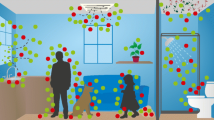Abstract
In recent years, potentially harmfulmicroorganisms such as Stachybotryschartarum have garnered national attentionwhen implicated with indoor air problems. However, accurate assessment of biologicallycontaminated indoor air has proven to beprohibitively labor, time, cost, and trainingintensive. The model developed in this studyaccurately predicts the levels of biologicalindoor air contaminants for the GreaterCincinnati area using a number of independentvariables that can be quickly calculatedwithout expensive, time-consuming methods. Thirty-nine single-family residences in theGreater Cincinnati area were sampled usingAndersen two-stage viable microbial particlesizing sampler instruments loaded with MaltExtract Agar, Trypicase Soy Agar, Czapek'sCellulose Agar, and Corn Meal Agar. After airsampling, the Petri dishes were incubated, thenumber of colonies from each plate wereenumerated, and the total number of viablecolony forming units per cubic meter of airwere calculated. Independent variables (indoorrelative humidity, indoor temperature, outdoormold, season, water damage, visible mold,damaged materials, home age, remediationfactors, health questionnaire, number ofoccupants, and indoor pets) were then compared tothe dependent variable (fungal and bacterialbioaerosol counts) by multiple linearregression using Analyze-it® for Microsoft Excel®. The final air model predicted thetotal number of viable colony forming units percubic meter with 97% accuracy; the goal forthis model was 90% accuracy.
Similar content being viewed by others
References
American Conference of Governmental Industrial Hygienists (ACGIH): 1999a, TLVs and BEIs. Threshold Limit Values for Chemical Substances and Physical Agents, Biological Exposure Indices, American Conference of Governmental Industrial Hygienists, Cincinnati, Ohio.
American Conference of Governmental Industrial Hygienists: 1999b, Bioaerosols: Assessment and Control, American Conference of Governmental Industrial Hygienists, Cincinnati, Ohio.
Buttner M. and Stetzenbach L.: 1993, Monitoring airborne fungal spores in an experimental indoor environment to evaluate sampling methods and the effects of human activity on air sampling. Applied and Environmental Microbiology 59, 219–226.
Davis J.: 1973, Statistics and Data Analysis in Geology, John Wiley and Sons, New York, New York.
Den Boer J., Yzerman E., Schellekens J., Lettinga K., Bashuizen H., Van Steenbergen J., Bosman A., Van den Hof S., Van Vliet H., Peeters M., Van Ketel R., Speelman P., Kool J. and Spaendonck M.: 2002, A large outbreak of Legionnaires’ disease at a flower show, the Netherlands 1999. Emerg. Infe.c Dis. 8, 37–43.
Foarde K., Dulaney P., Cole E., VanOsdell D., Ensor D. and Chang J.: 1993, Assessment of fungal growth on ceiling tiles under environmentally characterized conditions. Proceedings of Indoor Air’ 93, Helsinki, Finland 4, 357–362.
Guerra M., Walker E., Jones C., Paskewitz S., Cortinas M., Stancil A., Beck L., Bobo M. and Kitron U.: 2002, Predicting the risk of lyme disease: habitat suitability for Ixodes scapularis in the North Central United States. Emerg. Infect. Dis. 8, 289–297.
Hamilton County Department of Environmental Services: 2002, Pollen and Mold Count Homepage www.hcdoes.org (viewed August 3, 2002).
Hong T.D., Ellis R.H. and Moore D.: 1997, Development of a model to predict the effect of temperature and moisture on fungal spore longevity. Annals of Botany 79, 121–128.
Husman T.: 1996, Health effects of indoor-air microorganisms. Scand J Work Environ Health 22, 5–13.
KulmalaM., Asmi A. and Pirjola L.: 1999, Indoor air aerosol model: the effect of outdoor air, filtration and ventilation on indoor concentrations. Atmospheric Environment 33, 2133–2144.
Malloch D.: 1981, Moulds; their Isolation, Cultivation, and Identification, University of Toronto Press, Toronto Canada.
Ott L.: 1984, An Introduction to Statistical Methods and Data Analysis, PWS Publishers, Boston MS.
Pasanen A., Kasanen J., Rautiala S., Ikaheimo M., Rantamaki J., Kaariainen H. and Kallioski P.: 2000, Fungal growth and survival in building materials under fluctuating moisture and temperature conditions. International Biodeterioration and Biodegradation 46, 117–127.
Pathak D, Davis E. and Stanford R.: 2002, Economic impact of asthma therapy with fluticasone propionate, montelukast, or zafirlukast in a managed care population.
Portnoy J., Flappan S. and Barnes, C.: 2001, A procedure for evaluation of the indoor environment. Aerobiology 17, 43–48.
Ritchkoff A., Viitanen H. and Koskela K.: 2000, The response of building materials to the mould exposure at different humidity and temperature conditions. Proceedings of Healthy Buildings 3, 317–322.
Shelton B., Kirkland K., Flanders W. and Morris G.: 2002, Pro-files of airborne fungi in buildings and outdoor environments in the United States. Applied and Environmental Microbiology 68, 1743–1753.
Thermo-Andersen: 2001. Homepage www.a-i-i.com (viewed August 3, 2002).
United States Environmental Protection Agency (USEPA): 2001, Mold Remediation in Schools and Commercial Buildings, USEPA Office of Air and Radiation, Indoor Environments Division.
Verhoeff A.P. and Burge H.A.: 1997, Health risk assessment of fungi in home environments. Ann Alergy Asthma Immunol 78, 544–554.
Viitanen H., Hanhijarvi A., Hukka A. and Koskela K.: 2000, Modeling mould growth and decay damages. Proceedings of Health Buildings 3, 341–346.
Walpole R. and Myers R.: 1989, Probability and Statistics for Engineers and Scientists 5th edition, MacMillan Publishing Co., New York, NY.
Author information
Authors and Affiliations
Corresponding author
Rights and permissions
About this article
Cite this article
Green, C.F., Scarpino, P.V. & Gibbs, S.G. Assessment and modeling of indoor fungal and bacterial bioaerosol concentrations. Aerobiologia 19, 159–169 (2003). https://doi.org/10.1023/B:AERO.0000006531.35387.bd
Issue Date:
DOI: https://doi.org/10.1023/B:AERO.0000006531.35387.bd




